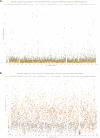Description of Staphylococcal Strains from Straw-Coloured Fruit Bat (Eidolon helvum) and Diamond Firetail (Stagonopleura guttata) and a Review of their Phylogenetic Relationships to Other Staphylococci
- PMID: 35646742
- PMCID: PMC9132046
- DOI: 10.3389/fcimb.2022.878137
Description of Staphylococcal Strains from Straw-Coloured Fruit Bat (Eidolon helvum) and Diamond Firetail (Stagonopleura guttata) and a Review of their Phylogenetic Relationships to Other Staphylococci
Abstract
The phylogenetic tree of the Staphylococcus aureus complex consists of several distinct clades and the majority of human and veterinary S. aureus isolates form one large clade. In addition, two divergent clades have recently been described as separate species. One was named Staphylococcus argenteus, due to the lack of the "golden" pigment staphyloxanthin. The second one is S. schweitzeri, found in humans and animals from Central and West Africa. In late 2021, two additional species, S. roterodami and S. singaporensis, have been described from clinical samples from Southeast Asia. In the present study, isolates and their genome sequences from wild Straw-coloured fruit bats (Eidolon helvum) and a Diamond firetail (Stagonopleura guttata, an estrildid finch) kept in a German aviary are described. The isolates possessed staphyloxanthin genes and were closer related to S. argenteus and S. schweitzeri than to S. aureus. Phylogenetic analysis revealed that they were nearly identical to both, S. roterodami and S. singaporensis. We propose considering the study isolates, the recently described S. roterodami and S. singaporensis as well as some Chinese strains with MLST profiles stored in the PubMLST database as different clonal complexes within one new species. According to the principle of priority we propose it should be named S. roterodami. This species is more widespread than previously believed, being observed in West Africa, Southeast Asia and Southern China. It has a zoonotic connection to bats and has been shown to be capable of causing skin and soft tissue infections in humans. It is positive for staphyloxanthin, and it could be mis-identified as S. aureus (or S. argenteus) using routine procedures. However, it can be identified based on distinct MLST alleles, and "S. aureus" sequence types ST2470, ST3135, ST3952, ST3960, ST3961, ST3963, ST3965, ST3980, ST4014, ST4075, ST4076, ST4185, ST4326, ST4569, ST6105, ST6106, ST6107, ST6108, ST6109, ST6999 and ST7342 belong to this species.
Keywords: DNA microarray; Staphylococcus argenteus; Staphylococcus aureus; Staphylococcus roterodami; Staphylococcus schweitzeri; Staphylococcus singaporensis; whole genome sequencing (WGS).
Copyright © 2022 Monecke, Schaumburg, Shittu, Schwarz, Mühldorfer, Brandt, Braun, Collatz, Diezel, Gawlik, Hanke, Hotzel, Müller, Reinicke, Feßler and Ehricht.
Conflict of interest statement
DG is employed by a company, Illumina, but he performed experiments for this study before commencing this employment. The remaining authors declare that the research was conducted in the absence of any commercial or financial relationships that could be construed as a potential conflict of interest.
Figures




References
-
- Aung M. S., San T., Aye M. M., Mya S., Maw W. W., Zan K. N., et al. . (2017). Prevalence and Genetic Characteristics of Staphylococcus aureus and Staphylococcus argenteus Isolates Harboring Panton-Valentine Leukocidin, Enterotoxins, and TSST-1 Genes From Food Handlers in Myanmar. Toxins (Basel) 9 (8). doi: 10.3390/toxins9080241 - DOI - PMC - PubMed
-
- Aung M. S., San T., San N., Oo W. M., Ko P. M., Thet K. T., et al. . (2019). Molecular Characterization of Staphylococcus argenteus in Myanmar: Identification of Novel Genotypes/Clusters in Staphylocoagulase, Protein A, Alpha-Haemolysin and Other Virulence Factors. J. Med. Microbiol. 68 (1), 95–104. doi: 10.1099/jmm.0.000869 - DOI - PubMed
-
- Aung M. S., Urushibara N., Kawaguchiya M., Sumi A., Takahashi S., Ike M., et al. . (2019). Molecular Epidemiological Characterization of Staphylococcus argenteus Clinical Isolates in Japan: Identification of Three Clones (ST1223, ST2198, and ST2550) and a Novel Staphylocoagulase Genotype XV. Microorganisms 7 (10). doi: 10.3390/microorganisms7100389 - DOI - PMC - PubMed
-
- Becker K., Schaumburg F., Kearns A., Larsen A. R., Lindsay J. A., Skov R. L., et al. . (2019). Implications of Identifying the Recently Defined Members of the Staphylococcus aureus Complex S. argenteus and S. Schweitzeri: A Position Paper of Members of the ESCMID Study Group for Staphylococci and Staphylococcal Diseases (ESGS). Clin. Microbiol. Infect. 25 (9), 1064–1070. doi: 10.1016/j.cmi.2019.02.028 - DOI - PubMed
Publication types
MeSH terms
LinkOut - more resources
Full Text Sources
Molecular Biology Databases
Miscellaneous

